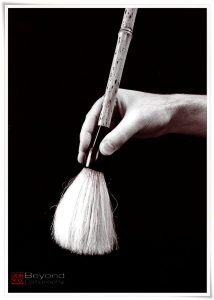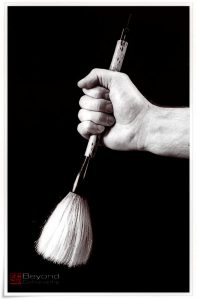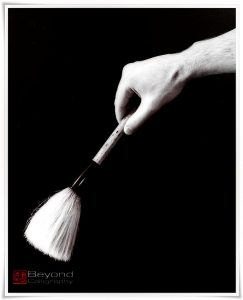The pair grip method and the simple grip method, both discussed in Part II (a) of this series, do not exhaust the ways of holding a calligraphy brush. Other methods (or variations of both) are as follows:

-
- 単包法 (たんほうほう, tanhō hō), where the ring finger and the small finger are adjacent to the inner side of the palm, and the brush is held with the three remaining fingers. This method is recommended for writing cursive script (草書, そうしょ, sōsho) when the brush is held similarly to (with the only difference that the ring finger and the small finger are adjacent to the inner palm) as shown in Figure 2 of the previous article, Part II (a). This method also applies to writing seal script (篆書, てんしょ, tensho), where maintaining the perpendicular angle of the brush to the paper is essential, if the brush is held in the middle of the brush handle. This method is a variation of the simple grip method.
- 双包法 (そうほうほう, sōhō hō), where the small finger is adjacent to the inner side of the palm, and the brush is held between the thumb and the three remaining fingers. This method is a variation of the pair grip method.
- 捻管法 (ねんかんほう, nenkan hō), literally “a pipe spinning method”, in this case the calligrapher holds the brush near the tuft and spins the hikkan (筆管, ひっかん, i.e. “brush axis”) in the fingertips while writing. This method is suitable for writing long columns of text on large paper. (Figure 1)

-
- 握拳法 (あつきょほう, atsukyo hō), or, in other words, “the fist grip method”, in which all fingers wrap around the axis of the brush. The line created by a brush held using this method is very powerful and bold, (Figure 3 and 4). I would strongly suggest using the method shown in Figure 3 only with extensively large brushes, i.e. big enough to be held with both hands (size of a broom).
- 三指法 (さんしほう, sanshi hō), i.e. “three fingers method”, which must be distinguished from the 単包法 (たんほうほう, tanhō hō) discussed above (see point 1). The ring and small fingers are not held firmly to the inner side of the palm but simply hover without touching the brush handle, again, please see Figure 2 of the previous article, Part II (a) This method is similar to the one in point 6, the difference being that one more finger is used (three instead of two). The brush ought to be gripped at the very end, greatly increasing the mobility of the brush tip. This method is preferable for Japanese kana script (かな) as well as cursive script (草書, そうしょ, sō`sho).
- 両指法 (りょうしほう, ryōshi hō), i.e. “both fingers method”. Same as the above, but with only two fingers gripping the brush handle. As you can imagine, this grip results in very little control over the brush as it is quite a loose grip. The line created by a brush held this way becomes very unpredictable and therefore has its own unique charm.

- 四指斉頭法 (ししせいとうほう, shishiseitō hō) is a method of holding the brush with all fingers, utilizing the fingertips, with the thumb on one side and four fingers joined parallel on the other. If you view Figure 4 of Part I of this article here, you can see this method in conjunction with the suspended arm technique. Since the brush is supported by all fingers, the mobility is rather low. I would suggest this method for writing in clerical script (隷書, れいしょ, reisho), or even seal script.
The chosen method of holding the brush should not be the ruling factor when writing. Although some methods may be rather unsuitable for certain scripts (such as “both fingers method” may not serve well the purpose of writing in standard script (楷書, かいしょ, kaisho), where brush control is essential, one should not hesitate to experiment with different ways of holding a calligraphy brush. Having said that, there is nothing wrong with cherishing one particular method over the others, a not uncommon practice among calligraphers.
